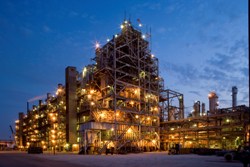Middle East eyes heavier ethylene feedstocks as US rides ethane wave
8/29/2013 12:00:00 AM
At the same time, producers in the Middle East -- facing the opposite and unfamiliar challenge of ethane supply limitations -- are shifting their focus to heavier feedstocks and delivering higher value-added products.
 These findings were presented in a new study released Thursday. The study, titled IHS Chemical 2014 World Ethylene Analysis, covers historical developments and future projections for supply, demand, capacity and trade in the global ethylene markets for 2008 to 2023.
These findings were presented in a new study released Thursday. The study, titled IHS Chemical 2014 World Ethylene Analysis, covers historical developments and future projections for supply, demand, capacity and trade in the global ethylene markets for 2008 to 2023. “Low regional ethane prices continue to support high ethylene margins for North American producers, while producers in other regions are facing an opposite situation,” said Steve Lewandowski, director of olefins research at IHS, and one of the authors of the report.
“Once blessed with abundant supplies of cheap ethane, Middle East producers invested heavily in capacity additions, but this market shift, and a lack of readily available ethane supplies, has effectively put a stop to new, low-cost ethane-based ethylene capacity and shifted investments to ethylene based on LPG’s (liquefied petroleum gas) and naphtha feedstocks.”
Producers in the Middle East, he said, face some challenges, such as a less developed infrastructure as compared to what exists in the US, and a mixed global-demand-growth environment (rapid expansion in developing regions and slower growth in developed regions).
According to the IHS Chemical analysis, after contracting considerably in 2008, world ethylene demand is forecast to be close to 140 million metric tons (MMT) in 2014. In the next 10 years, IHS estimates global ethylene demand will grow at approximately 4%/year, reaching nearly 196 MMT by 2023.
During the next 10 years, China and the Middle East will continue to be the largest drivers of global ethylene demand growth; however, since its domestic market is small, most of the Middle East demand for ethylene will be for export in the form of primary derivatives, such as polyethylene and ethylene glycol.
Ethylene demand growth in the Indian Subcontinent, Southeast Asia, South America and Africa also is projected to remain considerably above the global average, but from smaller absolute base levels.
In contrast, consumption volumes in North America and Europe are forecast to grow slowly for the next few years, but after 2016, the large-scale investments in nearly 14 MMT of North American ethylene capacity will require a substantial rise in ethylene derivative investment.
The new derivatives are primarily to feed exports to the rest of the world (South America, Asia, Europe, etc.), according to the IHS report.
"The US ethylene industry and the ethylene industry in the Middle East have essentially traded places in terms of supply outlook in the past few years, due to the emergence of low-cost feedstocks," said Lewandowski.
"There is a tremendous amount of US capital investment that is underway, with units starting up beginning in 2017. Middle East players wish to participate in the North America low-cost feedstock boom, and are seeking joint venture partners with North American companies as one entry strategy.”
Demand in Asia, particularly China, continues to grow since China’s chemical industry remains unable to meet the country’s rapidly growing consumption requirements, according to the report.
Sharp increases in consumption stemming from China’s rapid industrialization have spurred the development of numerous new domestic ethylene and derivative complexes that are either under construction or planned for the next few years, including several coal-based facilities.
According to the IHS report, imports of ethylene and ethylene derivatives into China will continue to increase rapidly during the next 10 years, when they are projected to be about 50% higher than the estimated 2013 volume of nearly 16 MMT.






Comments